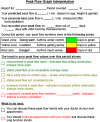Objective airway monitoring improves asthma control in the cold and flu season: a cluster randomized trial
- PMID: 20538819
- PMCID: PMC2972622
- DOI: 10.1378/chest.09-2394
Objective airway monitoring improves asthma control in the cold and flu season: a cluster randomized trial
Abstract
Background: The goals of asthma care are reductions in risk and impairment, but achieving these goals requires collaborative work between patients and their clinicians. The purpose of this study was to improve inhaled corticosteroid (ICS) adherence and asthma control by cueing therapeutic communication between patients with asthma and their primary care clinicians.
Methods: We conducted a prospective, cluster-randomized, controlled effectiveness trial to assess the effect of providing visually standardized, interpreted peak flow graphs (CUE intervention) to patients and their clinicians on ICS adherence and asthma control. Asthma control outcomes were analyzed by season to account for seasonal variations in exacerbation frequency.
Results: Although mean log-transformed ICS adherence was not significantly different between the two groups, there was a trend toward preserved adherence in the intervention group over time (P = .16). Intervention patients required fewer courses of oral steroids during winter (9% vs 23%, P < .001) and spring (3% and 17%, P < .001) compared with control subjects. Intervention patients also had fewer periods of worsening symptoms (65% vs 89%, P < .001) and fewer urgent care visits (10% vs 23%, P < .001) during winter compared with control subjects. Post hoc analysis showed significant improvement in the intervention group with respect to ICS adherence during winter months (P < .05), the likely explanation for the reduction in prednisone use and symptoms. Day-to-day peak flow variability in the intervention group fell consistently throughout the study from an average of 32% at baseline to 23% at final measurement (P < .001), indicating less airway reactivity over time.
Conclusions: Our findings provide evidence of the value of peak flow monitoring for patients with asthma during seasons of greatest vulnerability, the cold/flu season. The peak flow information apparently led to improvements in ICS adherence resulting in less need for prednisone rescue and fewer episodes of worsening symptoms.
Trial registration: ClinicalTrials.gov NCT00201188.
Figures





Similar articles
-
Effect of early versus late intervention with inhaled corticosteroids on airway wall thickness in patients with asthma.Respirology. 2008 Nov;13(7):1008-13. doi: 10.1111/j.1440-1843.2008.01384.x. Respirology. 2008. PMID: 18721183
-
Seasonal variability of lung function and Asthma Quality of Life Questionnaire Scores in adults with uncontrolled asthma.BMJ Open Respir Res. 2019 Nov 11;6(1):e000406. doi: 10.1136/bmjresp-2019-000406. eCollection 2019. BMJ Open Respir Res. 2019. PMID: 31803473 Free PMC article. Clinical Trial.
-
Variability of lung function predicts loss of asthma control following withdrawal of inhaled corticosteroid treatment.Thorax. 2010 May;65(5):403-8. doi: 10.1136/thx.2009.129668. Thorax. 2010. PMID: 20435861
-
Inhaled budesonide in addition to oral corticosteroids to prevent asthma relapse following discharge from the emergency department: a randomized controlled trial.JAMA. 1999 Jun 9;281(22):2119-26. doi: 10.1001/jama.281.22.2119. JAMA. 1999. PMID: 10367823 Clinical Trial.
-
Clinical effectiveness of inhaled corticosteroids versus montelukast in children with asthma: prescription patterns and patient adherence as key factors.Curr Med Res Opin. 2012 Jan;28(1):111-9. doi: 10.1185/03007995.2011.640668. Epub 2011 Dec 16. Curr Med Res Opin. 2012. PMID: 22077107 Review.
Cited by
-
Differences between asthmatics and nonasthmatics hospitalised with influenza A infection.Eur Respir J. 2013 Apr;41(4):824-31. doi: 10.1183/09031936.00015512. Epub 2012 Aug 16. Eur Respir J. 2013. PMID: 22903963 Free PMC article.
-
Recent educational interventions for improvement of asthma medication adherence.Asia Pac Allergy. 2012 Jan;2(1):67-75. doi: 10.5415/apallergy.2012.2.1.67. Epub 2012 Jan 25. Asia Pac Allergy. 2012. PMID: 22348209 Free PMC article.
-
Psychosocial factors and behavioral medicine interventions in asthma.J Consult Clin Psychol. 2013 Apr;81(2):231-50. doi: 10.1037/a0030187. Epub 2012 Oct 1. J Consult Clin Psychol. 2013. PMID: 23025250 Free PMC article.
References
-
- Kamble S, Bharmal M. Incremental direct expenditure of treating asthma in the United States. J Asthma. 2009;46(1):73–80. - PubMed
-
- Apter AJ, Reisine ST, Affleck G, Barrows E, ZuWallack RL. Adherence with twice-daily dosing of inhaled steroids. Socioeconomic and health-belief differences. Am J Respir Crit Care Med. 1998;157(6 pt 1):1810–1817. - PubMed
-
- National Asthma Education and Prevention Program Expert Panel Report 3 (EPR-3): guidelines for the diagnosis and management of asthma-summary report 2007. J Allergy Clin Immunol. 2007;120(5) suppl:S94–S138. - PubMed
-
- López-Viña A, del Castillo-Arévalo E. Influence of peak expiratory flow monitoring on an asthma self-management education programme. Respir Med. 2000;94(8):760–766. - PubMed

